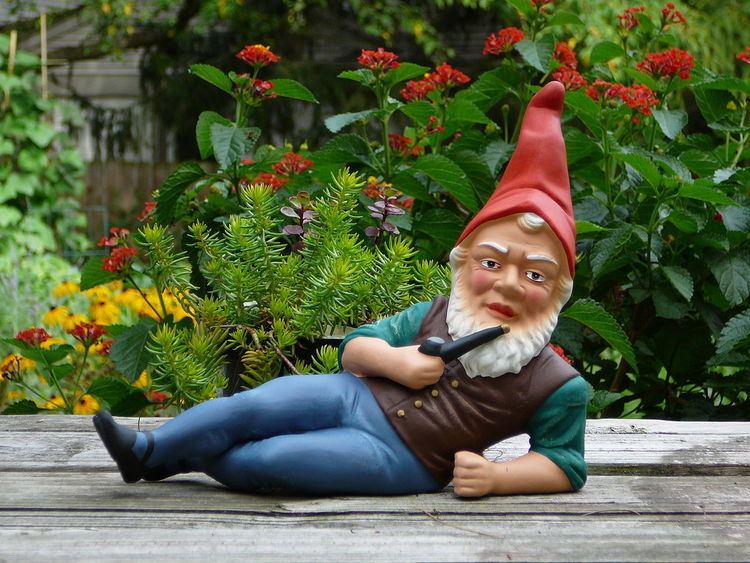 | ||
Garden gnomes (German: Gartenzwerge, 'garden dwarfs') are lawn ornament figurines of small humanoid creatures known as gnomes or dwarfs that are typically males wearing red pointy hats. First created in 19th-century Germany, garden gnomes spread to other countries in Europe in the 1840s and became particularly popular in France and Britain. The term "Garden Gnome" may originate from the term "gnomen-figuren" (miniature figurine), used in the original German catalogues, They had a resurgence in popularity in the 1930s after Disney's animated film, Snow White and the Seven Dwarfs, and were revived again in the 1970s.
Contents
Origins
In ancient Rome, small stone statues depicting the Greco-Roman fertility god Priapus, also a protector of plants and gardens, were frequently placed in Roman gardens. Garden gnomes were first described during the Renaissance period by Swiss alchemist Paracelsus as "diminutive figures two spans in height who did not like to mix with humans". During this period, stone "grotesques", which were typically garishly painted, metre-tall figurines, were commonly placed in the gardens of the wealthy. Among the figures depicted were gobbi (Italian for dwarfs or hunchbacks). In particular, Jacques Callot produced 21 versions of gobbi, which he engraved and printed in 1616. By the late 1700s, gnome-like statues made of wood or porcelain called "house dwarfs" became popular household decorations. The area surrounding town of Brienz in Switzerland was known for their production of wooden house dwarfs.
In Germany, these garden figurines became conflated with their traditional stories and superstitions about the "little folk" or dwarfs that they believed helped around the mines and on the farm. The Dresden company Baehr and Maresch had small ceramic statues of dwarfs or "little folk" in stock as early as 1841, and although the claim has been contested, some credit Baehr and Maresch with the first garden dwarfs (German: Gartenzwerge).
Within less than 10 years, statues of dwarfs had spread from the provinces of Saxony and Thuringia across Germany to France and, in 1847, Sir Charles Isham, brought 21 terracotta gnomes manufactured in Germany by Philip Griebel back to Britain where they were called "gnomes" in English and placed in the gardens of Isham's home, Lamport Hall in Northamptonshire. Nicknamed "Lampy", the only gnome of the original batch to survive is on display at Lamport Hall and insured for GB£1 million.
Production and popularity
The manufacturing of gnomes spread across Germany, with numerous other large and small manufacturers coming in and out of the business, each having its own particular style of design. From around 1860 onwards, many statues were made in Gräfenroda, a town in Thuringia, known for its ceramics.
The reputation of German gnomes declined after World War I, but they became popular again in the 1930s following Disney's animated film Snow White and the Seven Dwarfs, when more working-class people were able to purchase them. Tom Major-Ball (father of former British prime minister John Major) was the most notable producer at that time with his company Major's Garden Ornaments. World War II and the years following were also hard on the industry, and most producers gave it up then.
Garden gnomes saw a resurgence in popularity again in the 1970s with the creation of more humorous types of gnomes. In the 1990s travelling gnome and garden gnome pranks became and made national news at times, where people steal a garden gnome from an unknowing person's lawn and then send the owner photos of the gnome as a practical joke before returning it.
Philip Griebel's descendants are still producing garden gnomes in Germany. As of 2008, there were an estimated 25 million garden gnomes in Germany.
In pop culture and politics
A subplot in the 2001 French movie Amélie revolves around a garden gnome.
Gnomeo and Juliet is a 2011 British-American CGI film that is inspired by the tragedy of Romeo and Juliet featuring garden gnomes as the characters.
The Social Democratic Party of Austria (SPÖ) used garden gnomes, which they called "Coolmen", in their campaign for the 2014 regional elections in Vorarlberg. It was intended as an ironic pun since the SPÖ historically performed poorly in elections in this part of Austria and considered itself to be a political "dwarf". The campaign placed 20,000 Coolmen holding small posters with short slogans along highly frequented roads. The party made a police report after 400 of them went missing, drawing attention from the international media.
The 2010 video game Fable III includes a side mission where a collection of garden gnomes are given magical properties, which the player character must collect throughout the world.
Types of garden gnomes
Garden gnomes are typically males, often bearded, usually wear red phrygian caps and often have pipes. They are made in various poses and shown pursuing various pastimes, such as fishing or napping.
Gnomes have become controversial in serious gardening circles in the UK, and have been banned from the prestigious Chelsea Flower Show, as the organisers claim that they detract from the garden designs. The ban was lifted during 2013 to mark the show's centenary. Gnome enthusiasts have accused the organisers of snobbery as garden gnomes are popular in the gardens of working class and suburban households.
Gnomes may be made from terracotta clay slip (runny clay) poured into molds. This is allowed to set up and the excess emptied from the centre, leaving a clay shell. The gnome is removed from the mold when firm, allowed to dry and then fired in a kiln until hard. Once cooled, the gnome is painted. More modern gnomes are made from resins and similar materials.
Today, many different variations of garden gnomes exist, including humorous ones like a gnome stabbed in the back or one with an executioner's hood.
